
The minor shoulder-knot is a moth of the family Noctuidae. The species was first described by Johan Christian Fabricius in 1776. It is distributed throughout Europe then east across the Palearctic to Siberia and Japan. It also occurs in Turkey.

The poplar grey is a moth of the family Noctuidae. It is found throughout Europe.

Fissipunctia ypsillon, the dingy shears, is a species of moth of the family Noctuidae. It is found in the Palearctic realm.

Catocala sponsa, the dark crimson underwing, is a species of moth of the family Erebidae. It is found in Europe, North Africa and from Anatolia up to the Caucasus.

Mythimna obsoleta, the obscure wainscot, is a moth of the family Noctuidae. The species was first described by Jacob Hübner in 1803. It is found in Europe, from southern Fennoscandia to Spain, Italy and the Balkans, the European part of Russia, the Caucasus, Kazakhstan, Kyrgyzia, southern Siberia, Turkey, the Ural, Mongolia, the Russian Far East, the Korean Peninsula, China and Hokkaido and Honshu in Japan.

Chersotis multangula is a moth of the family Noctuidae. It is found in the mountainous areas of Central and Southern Europe, Morocco, Turkey, Armenia, Iran, Syria, Lebanon and the Caucasus.

Dichagyris musiva is a moth of the family Noctuidae. It is found in some mountainous areas of Europe, Turkey, Armenia, the Caucasus, Anatolia, southern Siberia, Mongolia, Tibet and western China.
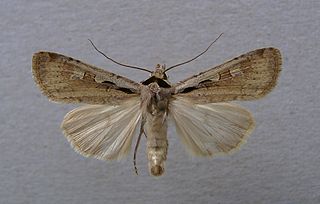
Dichagyris flammatra, the black collar, is a moth of the family Noctuidae. The species was first described by Michael Denis and Ignaz Schiffermüller in 1775. It is found in central and southern Europe, Morocco, Algeria, Egypt, western Siberia, Armenia, the Caucasus, Turkey, Lebanon, Syria, Iraq, Iran, Tibet, Afghanistan and northern India.

Agrotis trux, the crescent dart, is a moth of the family Noctuidae. The species was first described by Jacob Hübner in 1824. It has a circum-Mediterranean distribution and is found along the coasts of France, Ireland, England, southern Europe, Algeria, Syria, Iraq, Iran, southern Russia and the Arabian Peninsula. In Africa, it is found as far south as South Africa.
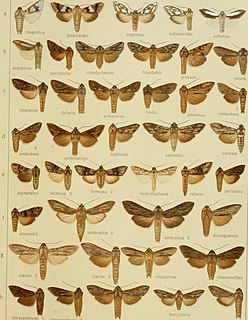
Cucullia santolinae is a moth of the family Noctuidae. It is found in southern Europe, northern Africa, Turkey, the Caucasus region and Israel.
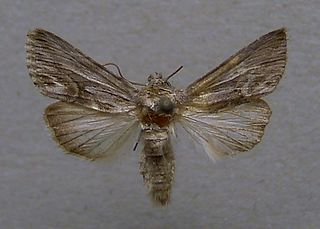
Calophasia platyptera, the antirrhinum brocade, is a moth of the family Noctuidae. The species was first described by Eugenius Johann Christoph Esper in 1788. It is found in Europe, the Near East, the western Sahara, Morocco, Algeria and Tunisia.

The shoulder-striped clover is a species of moth of the family Noctuidae. It is found in most of Europe, Ukraine, southern Russia and southern Siberia, Transbaikalia, Turkey, central Asia, China, Japan, the Korean Peninsula, Mongolia, northern India, Pakistan, the Russian Far East.

Apamea oblonga, the crescent striped, is a moth of the family Noctuidae. The species was first described by Adrian Hardy Haworth in 1809. It is found in northern and central Europe, east to southern Russia, Asia Minor, Armenia, Turkestan, Turkey, Iran, southern Siberia, northern Pakistan, Mongolia, China, Sakhalin and Japan

Dichagyris celsicola is a moth of the family Noctuidae. It is found in Greece, France, Italy and Turkey. It might also be present in Iran and Iraq.

Athetis pallustris, the marsh moth, is a moth of the family Noctuidae. It is found in most of Europe, the southern Urals, southern Russia, Ukraine, eastern Turkey, Siberia, the Amur region, the Russian Far East, Mongolia and northern China.
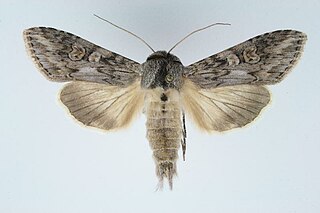
Cucullia artemisiae, or scarce wormwood, is a moth of the family Noctuidae. The species was first described by Johann Siegfried Hufnagel in 1766. It is found from central and southern Europe to Turkey and across the Palearctic to western Siberia, Central Asia, Manchuria, the Korean Peninsula and Japan.

Dichagyris constanti is a moth of the family Noctuidae. It is found in Algeria, Morocco, south-western Europe, southern France, and northern Italy. Warren (1914) states E. constanti Mill. Forewing pale yellow, dusted with darker especially in median area; the lines fine ; the subterminal punctiform ; stigmata very faint ; hindwing white, with the fringe and margin yellowish.Recorded only from the Ardeche, France.

Barrett's marbled coronet is a species of moth of the family Noctuidae. It is found from France through south-eastern Europe to Central Asia. In the north it is found up to the Baltic region. It is also present in North Africa.
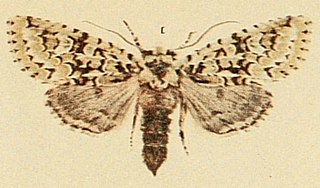
Griposia aprilina, the merveille du jour, is a moth of the family Noctuidae. The species was first described by Carl Linnaeus in his 1758 10th edition of Systema Naturae. It ranges from Sardinia and south-east Russia from the southernmost part of Norway and Saint Petersburg through northern and central Europe to southern France and northern Italy, as well as in Castile. Also in western and central Anatolia and the Caucasus. Also in Asia minor. There is recent evidence from the Alborz mountain range.
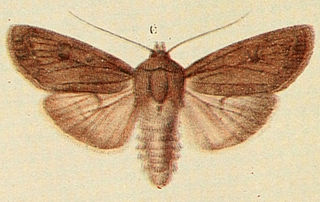
The Scarce Arches is a moth of the family Noctuidae. It is found in central and eastern Europe and in southern Scandinavia. north Germany, Russia including the Ural Mountains, west and east Turkestan. It is not known to breed in Britain, occurring only as a migrant.




















